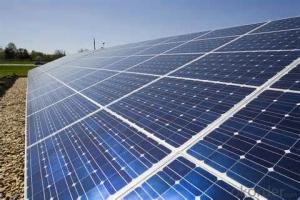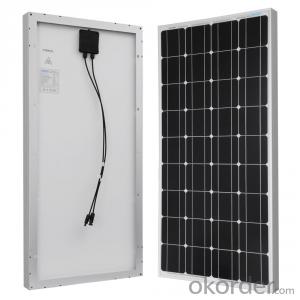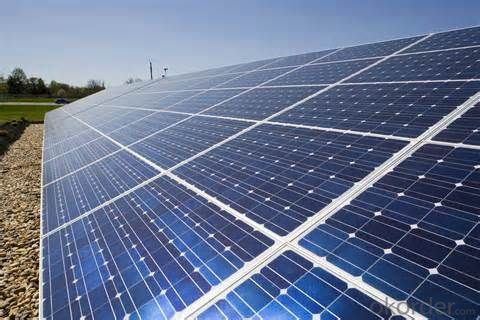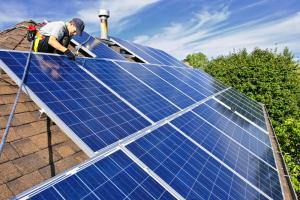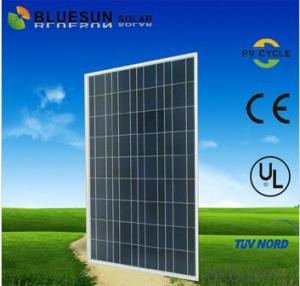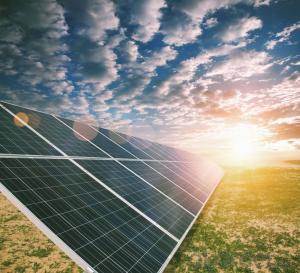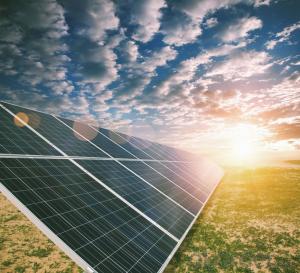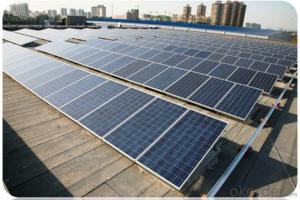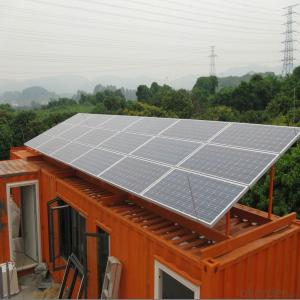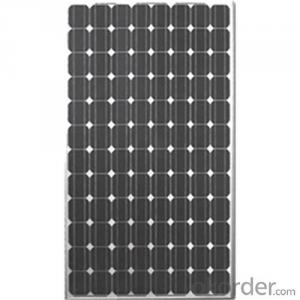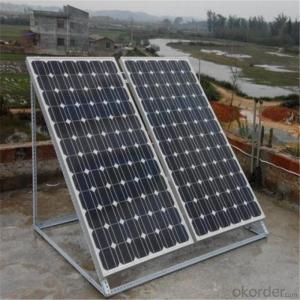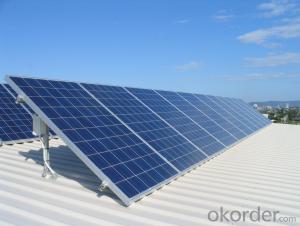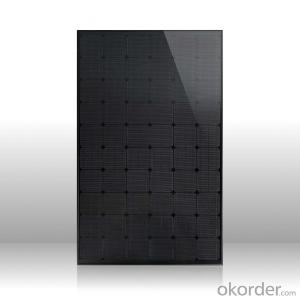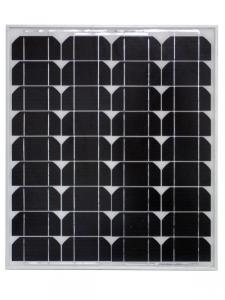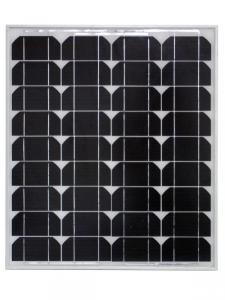12V Polycrystalline Solar Panels 250W with High Efficiency
- Loading Port:
- China main port
- Payment Terms:
- TT OR LC
- Min Order Qty:
- 1000 watt
- Supply Capability:
- 1000000 watt/month
OKorder Service Pledge
OKorder Financial Service
You Might Also Like
Specification
Introduction of Poly solar panels CNBM
Polycrystalline Solar Panels 250W With High Efficiency
CNBM Solar photovoltaic (PV) Panel is designed for large electrical power requirements. It is the optimal choice for both on-grid and off-grid power systems. CNBM Solar panel offers high performance of power per square foot of solar array. Monocrystalline silicon(c-Si): often made using the Czochralski process. Single-crystal wafer cells tend to be expensive, and because they are cut from cylindrical ingots, do not completely cover a square solar cell module without a substantial waste of refined silicon. Hence most c-Si panels have uncovered gaps at the four corners of the cells.
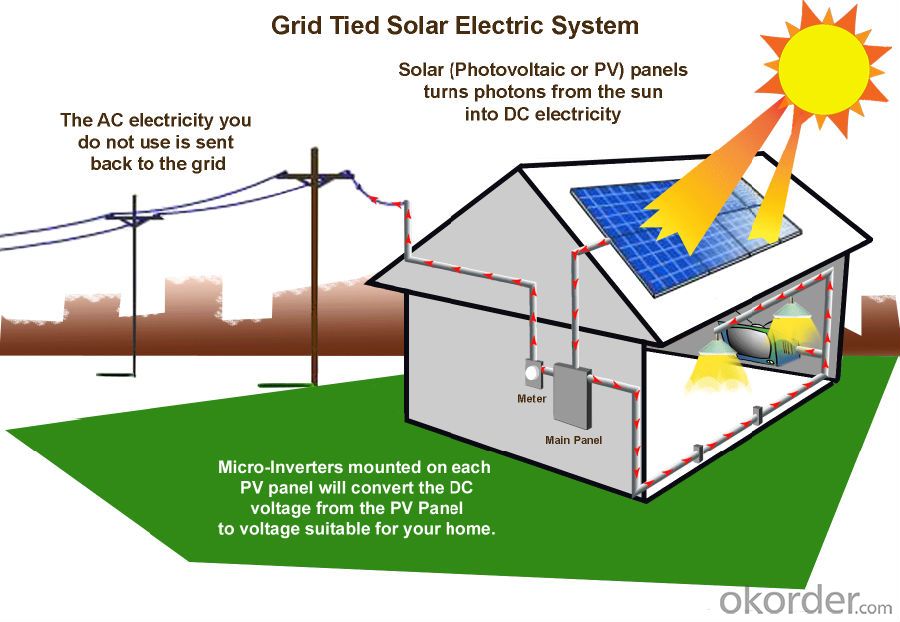
Feature
1.Solar Cell : High efficiency crystalline solar cell. Even if under the weak light, the solar module can produce maximum power output.
2.Tempered glass (toughened glass): Anti-reflecting coating and high transmission rate glass increase the power output and mechanical strength of solar module.
3.EVA and TPT: Using high quality EVA and TPT to prevent destroying and water.
4.Long lifetime: ≥25 years; Less power decrease.
5.Resisting moisture and etching effectively, not effected by geology.
6.The certificate issued by international authority: UL, TUV, IEC, VDE, CE.
Specification
Characteristics of Poly solar panels CNBM | |||||
Max Power Voltage Vmp(V) | 30.3 | 30.8 | 31.1 | 31.4 | 31.85 |
Max Power Current Imp(A) | 7.60 | 7.64 | 7.73 | 7.81 | 7.85 |
Open Circuit Voltage Voc(V) | 36.1 | 36.6 | 37 | 37.3 | 37.68 |
Short Circuit Current Isc(A) | 8.50 | 8.55 | 8.65 | 8.75 | 8.85 |
Max Power Pm(W) | 230W | 235W | 240W | 245W | 250W |
Temperature Coefficient of Cells Poly solar panels CNBM | |
NOCT | 45℃ ± 2℃ |
Temperature Coeffucients of Isc (%/℃) | 0.0492 |
Temperature Coeffucients of Voc (%/℃) | -0.3374 |
Temperature Coeffucients of Voc (%/℃) | -0.4677 |
Mechanical Data of Poly solar panels CNBM | |
Dimension | 1638 × 982 × 40 mm |
Weight | 19.5 kg |
No. of Cells and Connections | 60 (6 ×10) |
Tolerance | 0 ~ + 5 W |
Cell | Monocrystalline Cell 156 × 156 mm |
Packing | 624 Pcs/40ft(H) Container |
Limits of Poly solar panels CNBM | |
Operating Temperature | -40℃ to +85℃ |
Storage Temperature | -40℃ to +85℃ |
Max System Voltage | 1000VDC(IEC) / 600VDC(UL) |
Guarantees of Poly solar panels CNBM | |
Products Guarantee | 12 yrs free from defects in materials and workmanship |
Performance Guarantee | No less than 90% within 10yrs and no less than 80% within 25yrs |
Certificates | TUV(IEC61215&IEC61730),VDE(IEC61215&IEC61730),UL,CE |
Packaging Information
Package:26pcs/box
Quantity:1 box/pallent
Loading Capacity:952pcs/40ft
- Q: . The 2v battery will only be turning a small 2v motor that will be turning very slowly yet possibly or a long time. 2. -2 hours max per day it will be running3. I want it to be fully sufficient on solar power once the energy in the battery runs out. What specifications for my panel do you think I will need. However, i have limited space so the smaller the better as long as it can do the jobP.S: I don't know much about electricity and solar power so simple answers please :)
- batteries are rated with the help of the CCA, chilly cranking Amps the better the CCa the longer it is going to very last, don,t imagine you want a charge Controller as your consistently drawing juice from it, the picture voltaic panel will keep the bat at its height , then even as the solar is down , the pump will draw off the bat,
- Q: Can solar panels be used to power a water treatment plant?
- Yes, solar panels can be used to power a water treatment plant. Solar energy can be harnessed through photovoltaic panels to generate electricity, which can then be used to power the various processes involved in water treatment, such as pumping, filtration, disinfection, and distribution. This not only reduces reliance on fossil fuels but also helps in creating a more sustainable and eco-friendly water treatment system.
- Q: how efficient are flexible solar panels?
- I don't have a number, but in general, no one uses a flexible panel unless they are compelled to. The efficiency is lower, and my experience is that they don't last. I had one a few years ago, and it lasted less than 2 years. My rigid panels came with a 25-year performance warranty, and are still working great after 7 years.
- Q: Can solar panels be installed on water treatment plants or utilities?
- Yes, solar panels can be installed on water treatment plants or utilities. In fact, many water treatment plants and utilities are increasingly adopting solar energy systems to reduce their reliance on traditional energy sources and lower their carbon footprint. Solar panels can be installed on the roofs of these facilities or on nearby open spaces to generate clean and renewable electricity to power their operations.
- Q: Can solar panels be installed in areas with high winds?
- Yes, solar panels can be installed in areas with high winds. However, it is important to design and install the solar panel system with wind load considerations. Proper anchoring and structural support should be implemented to ensure the panels can withstand strong winds without causing any damage.
- Q: I've been figuring ways to keep water thawed out this winter, and this bucket seems to be the easiest thing. What kind of set up (solar panel) would I need to feed this 260 watt heated bucket?
- Unfortunately solar panels are low output,generally only 2 volt and very low amperage,so you would need to build a multi panel array with a DC-AC converter all together costing several hundred dollars which would only work during sunlight.Just roughly figuring,about $800. Plan2-Solar charger,battery bank,and DC-AC inverter so it would work 24hrs a day,also several hundred $$. Solar power does just not seem feasible(to me)in this application.By far the cheapest set up here would be an extension cord fromhouse to the bucket.260 watts per hr is a fairly lightweight draw,even not figuring the thermostat's cycling it on and off as needed.Electricity is sold in kilowatt hours(000W/hr).This bucket would use(not allowing for thermostats control lowering it)appx 6000watts or 6KW per day.Depending on your electrical cost per Kwh it would cost very little to run.(In my location appx 50cents a day) or appx the same amount as my computer(325watts total)) Note that that would be a maximum rate,and would actually be less due to thermostat cycling off and on as needed.
- Q: Can solar panels be used for heating a greenhouse?
- Yes, solar panels can be used for heating a greenhouse. Solar panels can be used to generate electricity, which can then be used to power heating systems in a greenhouse. This can help maintain a consistent and optimal temperature for plant growth. Additionally, solar panels can also be used to heat water, which can be circulated through a greenhouse to provide warmth.
- Q: Can solar panels be installed on train stations?
- Yes, solar panels can be installed on train stations. In fact, many train stations around the world are adopting solar energy systems to power their operations and reduce their carbon footprint. Solar panels are installed on the roofs or canopies of train stations to harness sunlight and generate electricity, which can be used for lighting, heating, cooling, and other station facilities. This renewable energy source makes train stations more sustainable and helps in the transition towards a greener transportation system.
- Q: I really need to know about the good companies who are selling good quality home solar panels.I lives in Pakistan, solar panels sell here are cheap but they doesn't work for long time, mostly they are quot;made in chinaquot;.Consumption of units of our house written on our electricity bill is 300.My dad is seriously thinking of purchasing a solar energy system for house that long last and works efficiently.So plz help me out.
- reckoning on the place you reside, the mixture of federal, state and city tax credit and rebates can offset the cost of photograph voltaic panels appreciably. however, till you utilize fairly some electrical energy, it ought to take some years for the panels to pay for themselves. you're truly paying for your electrical energy beforehand. The extra you utilize and the extra it expenses according to kW/hr, the speedier the cost would be offset by employing the mark downs. do no longer setting up photograph voltaic panels on a house you're renting or one which you will possibly sell contained in right here couple of years. it is not functional to un-setting up them and pass them to a clean homestead. power conservation is a thank you to cut back your enery expenditures with the backside up front cost. in case you have no longer had an power audit, see in the adventure that your power provider does them at low or free of charge. setting up timers on air conditioner thermostats. in case you have electric powered water heating, have a timer put in on that besides. Water heating is between the main important power wasters available. Why save the entire tank of water warm once you basically use it interior the morning to bathe? in case you have your heart set on having photograph voltaic panels yet can no longer handle to pay for the upfront cost, analyze the companies that do installations on your section. some have hire and hire/purchase innovations now.
- Q: i used 734 killowatts of power last month, any idea on how many solar panels i would need. What im looking for is to somehow hook up my central air to solar panels.
- LOL!! There is a lot more to this than you might imagine. This is a very rough approximation but look at the attached and column labeled 6.3KW. Look down that column and you see where it says Est. First Year KWH Generated ,025. So if we were to assume that each month it will produce ,025/2 kwh. (not true for January but I am trying to keep this simple. The installed price without any rebates is $44,050. ;-) Sorry! You will find some a little cheaper... some a little more expensive but none are a LOT cheaper than this. (this price does not even include energy storage, so the sun goes down and you will stop producing electricity). This is why, when people start looking at this sort of thing, they always do what they can to conserve electricity first. It is always much cheaper to conserve, then worry about alternate energy.
Send your message to us
12V Polycrystalline Solar Panels 250W with High Efficiency
- Loading Port:
- China main port
- Payment Terms:
- TT OR LC
- Min Order Qty:
- 1000 watt
- Supply Capability:
- 1000000 watt/month
OKorder Service Pledge
OKorder Financial Service
Similar products
Hot products
Hot Searches
Related keywords
